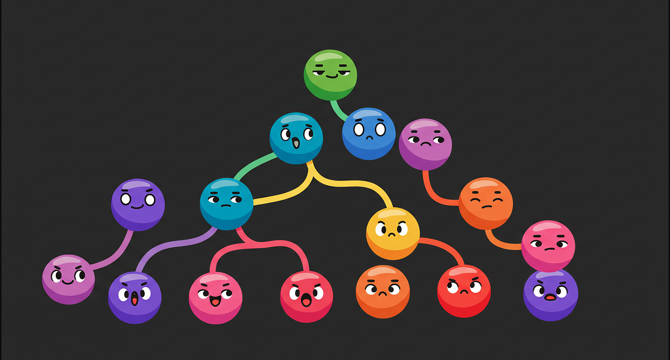Programming News
Dev
85

Image Credit: Dev
Rank It Your Way with Tierlyst! 🎯✨
- Tierlyst is a sleek and responsive tier list editor perfect for ranking various items such as games, characters, anime, and more.
- Key Features of Tierlyst include Drag & Drop functionality for desktop and Touch Controls for mobile, Custom Image Upload, Full Customization options, Exporting as PNG or Save as JSON, No Signups required, and Multi-Language support.
- Tech Stack used in Tierlyst includes React / Next.js, Tailwind, Framer Motion, html-to-image, and next-intl.
- Explore Tierlyst at https://tierlyst.vercel.app/ for an intuitive ranking experience.
Read Full Article
5 Likes
Dev
381

Image Credit: Dev
Why Functional Decomposition Leads to Bad System Design
- System decomposition should clearly show how components interact to prevent future difficulties in maintenance and extension.
- Avoid functional decomposition as it creates complex dependencies, inhibits component reuse, and leads to tight coupling within systems.
- Functional decomposition categorizes services based on tasks performed, resulting in rigid service sequences and limited reusability.
- Relying on functional decomposition makes services tightly coupled, bloated, and difficult to maintain or extend over time.
- Having the client handle service calls increases its complexity and ties it closely to system logic, leading to challenges in adapting to changes.
- Multiple entry points for clients increase redundancy, effort, and costs, while a unified entry point simplifies architecture and management.
- Beware of bad system design caused by functional decomposition, as it introduces unnecessary complexity and tight coupling.
- Anti-design patterns and strategies to avoid functional decomposition will be explored in upcoming articles by the author.
- Continuous learning and practice of effective system design principles are crucial in ensuring robust and scalable software solutions.
- Check the previous article linked in the conclusion for further insights on system decomposition and design principles.
Read Full Article
22 Likes
Dev
336

Image Credit: Dev
Retrieving System MAC Address Across OS Platforms
- A PHP function is presented for retrieving the MAC address of a server, catering to Windows and Linux/Unix/Mac environments.
- Operating system detection is done using strtoupper(substr(PHP_OS, 0, 3)) to differentiate between Windows and non-Windows systems.
- For Windows, the function captures the output of 'getmac' command to extract and return the MAC address using a regular expression.
- In Linux/Unix/Mac environments, the function uses 'ifconfig' or 'ip link' along with 'grep' to extract and return the MAC address.
- Error handling is implemented to manage exceptions that may occur during the command execution in the PHP script.
- Important considerations include permissions for executing system commands, handling multiple network interfaces, security risks, and environment differences.
- Overall, the PHP snippet offers a practical method to obtain the system's MAC address across various OS platforms, emphasizing caution and awareness.
- Considerations about virtualization and containers are also highlighted in terms of MAC address retrieval.
- The script's functionality, including regex matching for MAC address extraction, provides versatility for different system setups.
- I hope this summary helps you understand the PHP function for retrieving system MAC addresses comprehensively.
- Happy coding and stay mindful of security implications and environmental variations in MAC address retrieval processes!
Read Full Article
20 Likes
Dev
399

Image Credit: Dev
T vs any in TypeScript
- Both 'any' and generic 'T' in TypeScript mean 'could be any kind of type', but there is a significant difference.
- 'any' is never constrained, while generic 'T' is always under constraint somewhere.
- Example with generic 'T': 'T' is under constraint, specifying that 'stuff' can only be of 'T' type, and the return type can only be an array of 'T'.
- Example with 'any': 'any' is not constrained by anything, allowing code to be valid even if it doesn't achieve the initial goal.
Read Full Article
24 Likes
Discover more
- Software News
- Web Design
- Devops News
- Open Source News
- Databases
- Cloud News
- Product Management News
- Operating Systems News
- Agile Methodology News
- Computer Engineering
- Startup News
- Cryptocurrency News
- Technology News
- Blockchain News
- Data Science News
- AR News
- Apple News
- Cyber Security News
- Leadership News
- Gaming News
- Automobiles News
Dev
4

Image Credit: Dev
AltSchool Of Engineering Tinyuka’24 Month 3 Week 5
- CSS Grid Layout simplifies complex and responsive web designs by arranging elements into rows and columns with minimal code.
- Grid Container is created by setting display property to grid or inline-grid; define rows and columns using grid-template-rows and grid-template-columns.
- Control item placement with grid-column and grid-row properties; create spacing with grid-gap, row-gap, and column-gap.
- Name grid areas with grid-template-areas and position items within those areas using grid-area.
- Responsive design is facilitated using functions like repeat() and minmax() to adjust the grid based on available space.
- Positioned layout allows precise control over element placement, offering relative, absolute, fixed, and sticky positioning options.
- Anchor positioning enables elements to be positioned relative to another element's location on the page, simplifying layout designs.
- Understanding z-index, stacking contexts, and the natural stacking order in CSS is essential for controlling visual layering of elements.
- Overflow property controls content display when it exceeds its container's boundaries, with values like auto, hidden, scroll, visible, and clip.
- Creating scroll containers using the overflow property allows content to remain within specified boundaries while enabling scrolling to access overflowed content.
Read Full Article
Like
Dev
251

Image Credit: Dev
PlankDB – A Quantum-Powered Key-Value Store with Grover Search and Spring Boot
- PlankDB is an experimental key-value store that integrates quantum computing for probabilistic search using Grover's algorithm.
- It is built using Java 17 and Spring Boot, following Clean Architecture principles, and offers integration with IBM Qiskit for local or remote quantum execution.
- With PlankDB, users can create collections, insert key-value entries, and perform classical or quantum-powered search queries without needing to understand the complex math behind Grover's algorithm.
- The project is open-source on GitHub (https://github.com/swampus/plank-db) and welcomes feedback, contributions, and engagement from the community to explore real-world applications of quantum technology.
Read Full Article
15 Likes
Medium
143

Image Credit: Medium
Starting My Machine Learning Journey: Why I’m Learning in Public
- The author is starting their machine learning journey and is excited about building something cool using ML, like an app that predicts memes or tunes music to your mood.
- They believe that understanding ML requires math and code, so they are focusing on object-oriented programming and plan to dive into Stanford's courses on AI concepts and reinforcement learning.
- They plan to create beginner-friendly content to give back to the community and find learning in public more enjoyable than learning alone.
- The blog will contain messy, honest, and helpful posts about tools, resources, mindsets, and the journey of learning ML, inviting others to join them on this learning path.
Read Full Article
8 Likes
Dev
112

Image Credit: Dev
Getting Started with Amazon Q Developer CLI by Building a Game
- Amazon introduced Amazon Q Developer CLI, a generative AI coding assistant for developers.
- Amazon Q Developer CLI allows code generation, debugging, template creation, and application management within the terminal.
- Setting up Amazon Q Developer CLI involves specific steps for different operating systems like Windows, Linux, or macOS.
- A guide for Windows users using Windows Subsystem for Linux (WSL) to install Amazon Q CLI is provided.
- After installation, users can log in, run q doctor command, and start interacting with q chat directly from the terminal.
- Users can quickly build a game using Python and Pygame through Amazon Q Developer CLI by providing prompts.
- Amazon Q effectively scaffolds the project for a 2D Platformer Game with various features like player character, platforms, collectibles, enemies, game states, and UI elements.
- The game includes mechanics like gravity, jumping, collision detection, score, lives, and smooth gameplay loop.
- Users can further enhance the game by adding levels, power-ups, or improving visuals using sprites.
- Amazon Q Developer CLI simplifies game development even for beginners, allowing for continuous improvement and feature additions.
Read Full Article
6 Likes
Dev
134

Image Credit: Dev
SAST, DAST, & SCA: The Cybersecurity Avengers Your Code Needs 🛡️💻
- SAST, DAST, and SCA are crucial for protecting code against cybersecurity threats and vulnerabilities.
- SAST (Static Application Security Testing) detects flaws in source code pre-runtime like SQL injection risks and hardcoded passwords.
- DAST (Dynamic Application Security Testing) simulates real attacks on running apps to find vulnerabilities like broken authentication and XSS.
- SCA (Software Composition Analysis) scans dependencies for risks in third-party code like outdated libraries and known vulnerabilities.
Read Full Article
8 Likes
Medium
278

Image Credit: Medium
PLC Integrator: The Key to Streamlined Industrial Automation
- PLC integrators specialize in designing, programming, and implementing control systems using PLC technology for industrial automation.
- They customize automation solutions for various operations, integrating PLC systems with other hardware to improve operational efficiency.
- The expertise of PLC integrators allows for tailored automation solutions, scalability, real-time monitoring, and simplified troubleshooting, enhancing productivity.
- Working with a PLC integrator brings long-term benefits like energy savings, waste reduction, and minimized labor costs, making operations more cost-effective and competitive.
Read Full Article
16 Likes
Dev
215

Image Credit: Dev
Data Definitions, Not Flowcharts
- Computer programs are best understood in terms of the data they consume, process, and produce, according to Frederick Brooks.
- Flowcharts are not the ideal tool for analyzing and designing a program; they are more suited for visualizing control flow.
- Emphasizing data definitions is crucial for implementing, designing, and documenting programs, serving as a link to problem analysis.
- Functional programming languages offer benefits in expressing functions and effects in terms of type definitions, enhancing precision in implementation.
Read Full Article
12 Likes
Dev
385

Image Credit: Dev
Automation 102 with Google Apps Script
- This article continues the discussion on Google Apps Script, focusing on writing basic logic using JavaScript fundamentals inside Apps Script to automate tasks with Google Forms and Gmail.
- Functions in Apps Script are reusable blocks of code that help in performing specific tasks and organizing code efficiently.
- Variables in Apps Script store values like texts, numbers, and lists, aiding in data manipulation within scripts.
- Logic in programming involves making decisions, where if/else statements are fundamental for introducing logic and decision-making into code.
- The switch-case statement provides an alternative to long if-else chains, making decision-making more organized by comparing a single variable against constant values.
- Loops like for and forEach are used in Apps Script to repeat actions multiple times, facilitating tasks such as sending multiple emails or iterating through arrays.
- Automating tasks can be done with Google Forms and Apps Script by creating triggers to send emails based on form submissions with specific criteria.
- To automate email sending from Google Forms, a script is written to extract form responses and send a customized email using MailApp service in Apps Script.
- After setting up triggers in the script editor, responses submitted through the Google Form will trigger the automated email sending process.
- Permissions need to be granted for the script to run successfully, with requests for access to manage spreadsheets and send emails on behalf of the user.
Read Full Article
23 Likes
Hackernoon
296

Image Credit: Hackernoon
You Can Now Talk To Your Repos Thanks to GitHub's MCP Server
- GitHub has released a new open-source Model Context Protocol (MCP) server to enhance GitHub Copilot's capabilities, offering features like customizable tool descriptions, integrated code scanning, and a new function for natural language queries.
- The MCP server allows agents to interact with GitHub functionalities and automate workflows, enabling developers to build AI-powered tools and apps that utilize GitHub's ecosystem. Visual Studio Code now natively supports MCP in GitHub Copilot.
- The community has welcomed the Copilot agent + MCP combo for streamlining workflows and automating tasks beyond code suggestions. Developers can now delegate real tasks and execute more productive workflows.
- GitHub's MCP server provides structured integration with public and private repos, enhancing AI tools by offering real-time development context. This release simplifies moving from issue identification to PR generation and code reviews, fostering automation and collaborative development practices.
Read Full Article
17 Likes
Dev
219

Image Credit: Dev
File I/O with std::fs and ? Error Propagation
- Rust's std::fs module provides tools for file I/O, combined with the ? operator for clean error handling.
- File I/O is crucial for applications to interact with external resources, and Rust excels in this.
- Using std::fs::read_to_string, reading a file content into memory is made simple.
- The ? operator in Rust helps propagate errors gracefully without extensive match statements.
- Writing to a file with std::fs::write combines file creation and writing efficiently.
- A minimalist file copy utility in Rust can be built in just 10 lines by combining read and write operations.
- Error handling with the ? operator simplifies code and makes error management more clear.
- Common pitfalls in file handling include neglecting error handling, memory issues with large files, and accidental file overwrites.
- Key takeaways include utilizing std::fs functions, leveraging the ? operator, and ensuring robust error handling in Rust.
- Next steps involve exploring advanced std::fs functionalities, buffered reading and writing, and custom error handling.
Read Full Article
13 Likes
Medium
89

Image Credit: Medium
Understanding Binary Trees and Binary Search Trees: A Comprehensive Guide
- A binary tree is a hierarchical data structure with each node having at most two children - left and right child, aiding in quick data organization for search, insertion, and deletion.
- Binary trees have been crucial in computer science since the 1950s, primarily used in expression parsing and sorting algorithms, with the introduction of self-balancing variants like AVL Trees for consistent performance.
- Binary Search Trees (BSTs) ensure logarithmic time operations for search, insert, and delete by following a specific property, but performance degrades when unbalanced.
- BST operations involve traversing the tree from the root, inserting by comparison, and replacing nodes based on child count, offering a clear and efficient data structure with extensive applications in databases, AI, and software development.
Read Full Article
5 Likes
For uninterrupted reading, download the app